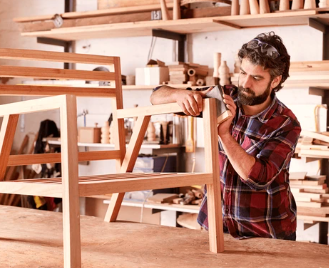Furniture manufacturing is the process of designing, producing, and assembling pieces meant to enhance both the functionality and aesthetics of our living and working spaces. Whether it’s a cozy recliner for your living room or an ergonomic chair for your home office, furniture plays a vital role in our day-to-day comfort and environment. This industry combines traditional craftsmanship with modern technology, creating pieces that reflect both utility and art.
History of Furniture Making
The art of making furniture dates back thousands of years. Ancient civilizations, from the Egyptians to the Greeks, created pieces with intricate carvings and symbolic meanings. Over time, the function of furniture evolved from basic utility to expressions of luxury and identity.
Early Techniques and Traditions
In earlier times, furniture was handmade from solid wood using simple tools. Artisans would carve, shape, and join each piece with dedication, passing down their skills through generations. Styles were often dictated by local materials and cultural traditions.
Industrial Revolution and Mass Production
The 19th century saw a massive shift with the advent of the Industrial Revolution. Machines allowed manufacturers to produce furniture on a large scale, making it more affordable and accessible. What once took weeks could now be completed in days, though often at the expense of craftsmanship.
Types of Furniture Manufactured
Furniture can be broadly categorized based on its use and market. Each category has its own design priorities, from comfort to functionality to elegance.
Residential Furniture: This includes sofas, beds, dining tables, chairs, and wardrobes—furniture made for the home. Designs often reflect personal taste and current trends, offering a mix of comfort and visual appeal.
Commercial and Office Furniture: Used in workplaces, hotels, and restaurants, this category emphasizes durability, functionality, and ergonomic support. Think of adjustable office chairs, modular desks, or compact conference tables.
Custom and Luxury Furniture: Tailor-made for high-end clients, custom furniture combines exclusivity with craftsmanship. Luxury furniture often uses premium materials like mahogany, Italian leather, or handblown glass.
Materials Used in Furniture Manufacturing
The choice of material greatly affects the design, durability, cost, and sustainability of furniture.
Wood and Timber: Wood remains the most classic and widely used material. Hardwoods like oak, maple, and teak are prized for their durability, while softwoods like pine are valued for affordability and ease of use.
Metal, Glass, and Plastics: Contemporary furniture often incorporates steel frames, tempered glass tops, or molded plastic for sleek, modern looks. These materials allow for innovative, space-saving designs.
Eco-Friendly and Recycled Materials: Sustainability is gaining ground. Bamboo, reclaimed wood, and recycled plastic are being used to reduce environmental impact while creating unique textures and finishes.
Furniture Design and Innovation
Design is the soul of modern furniture manufacturing. It transforms raw materials into expressions of style and comfort. Today’s designers use Computer-Aided Design (CAD) software to visualize, test, and tweak designs before a single piece is cut. This allows for precision, customization, and rapid prototyping. Minimalism, modularity, and multifunctional designs are popular in urban settings. Scandinavian, industrial, and boho styles continue to influence how manufacturers create pieces for today’s homes.
The Manufacturing Process
Furniture production involves several stages that blend creativity and engineering.
Concept and Sketching
Designers start with sketches or digital models. This phase outlines dimensions, materials, and color schemes.
Cutting and Shaping Materials
Materials are precisely cut and shaped using saws, routers, and CNC machines. This ensures consistency and reduces material waste.
Assembly, Finishing, and Quality Check
Pieces are assembled using nails, screws, adhesives, or joinery techniques. Finishing involves sanding, painting, varnishing, or upholstering. Finally, each item goes through a rigorous quality check before packaging.
Machinery and Tools Used in Production
CNC routers, edge banders, sanding machines, and laser cutters have revolutionized furniture manufacturing. These tools enhance speed, precision, and consistency while reducing labor-intensive tasks.
Skilled Labor in the Furniture Industry
Despite automation, skilled labor remains crucial. Craftsmen, upholsterers, and finishers bring a human touch to pieces that machines alone can’t replicate. Their attention to detail ensures the final product is not just functional, but beautiful.
Challenges in Furniture Manufacturing
Manufacturers face challenges like fluctuating raw material costs, supply chain disruptions, and intense global competition. Maintaining quality while staying cost-effective is a constant balancing act.
The Role of Sustainability
Eco-conscious consumers are pushing manufacturers to adopt greener practices. From sourcing certified woods to reducing VOC emissions in paints and finishes, sustainability is now a core business strategy.
Furniture Distribution and Supply Chain
Getting furniture from the factory to the customer involves warehouses, logistics partners, and retailers. Efficient packaging and damage-resistant materials are vital to minimize losses in transit.
How E-Commerce Changed the Furniture Industry
Online shopping has drastically reshaped how furniture is marketed and sold. Consumers now expect 3D previews, virtual room simulations, and doorstep delivery. E-commerce also forces manufacturers to focus on flat-pack designs for easier shipping.
Living Room with Red Sofa Ideas
A red sofa can be a bold centerpiece in any living room. It injects energy, warmth, and personality into the space. Pairing it with neutral walls—like beige, grey, or white—allows the red to shine without overwhelming the room. Add touches of black or gold through lamps or coffee tables for a classy contrast. Textures like velvet or leather enhance the luxurious feel, while patterned cushions in whites or golds bring in a playful vibe. A red sofa also works beautifully with wooden flooring and indoor plants, creating a cozy yet vibrant atmosphere. Whether modern or vintage, a red sofa opens up endless design possibilities for those who dare to decorate boldly.
Future of Furniture Manufacturing
The future lies in smart furniture, automation, and sustainability. From beds that track your sleep to modular furniture that adapts to tiny homes, the possibilities are exciting. Augmented reality, AI-driven design, and sustainable materials will define the next generation of furniture.
Conclusion
Furniture manufacturing is far more than assembling chairs and tables. It’s a harmonious blend of art, science, history, and innovation. From ancient woodwork traditions to AI-powered design, the journey of furniture reflects the changing tastes, values, and needs of society. As sustainability and technology continue to influence the industry, one thing remains constant: our need for spaces that feel like home, filled with furniture that reflects who we are.

